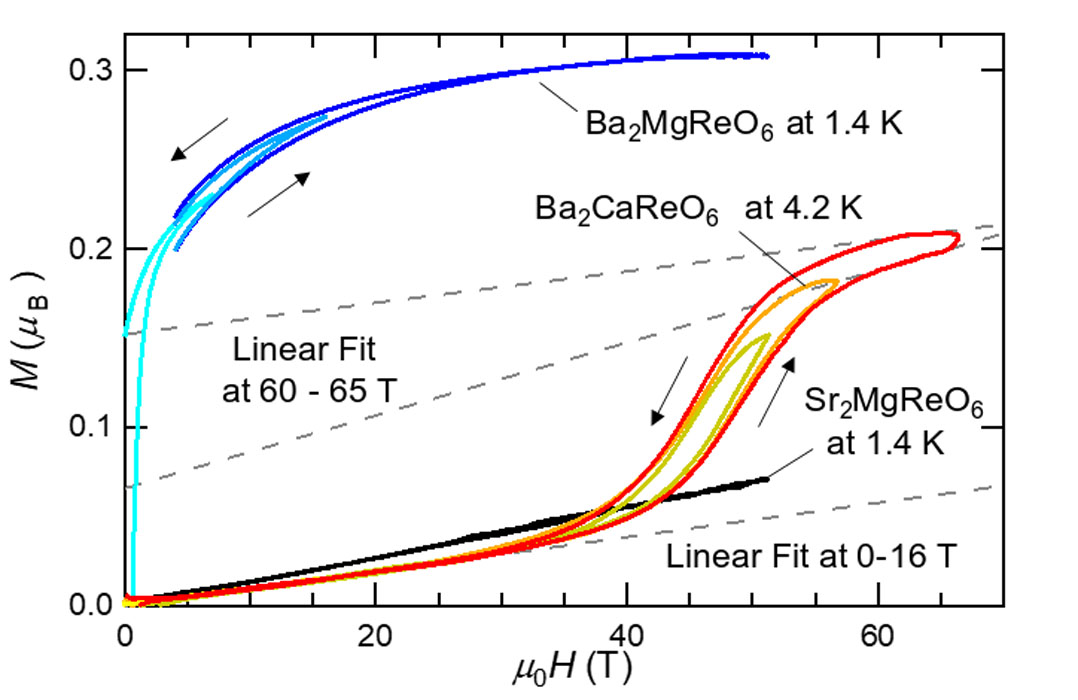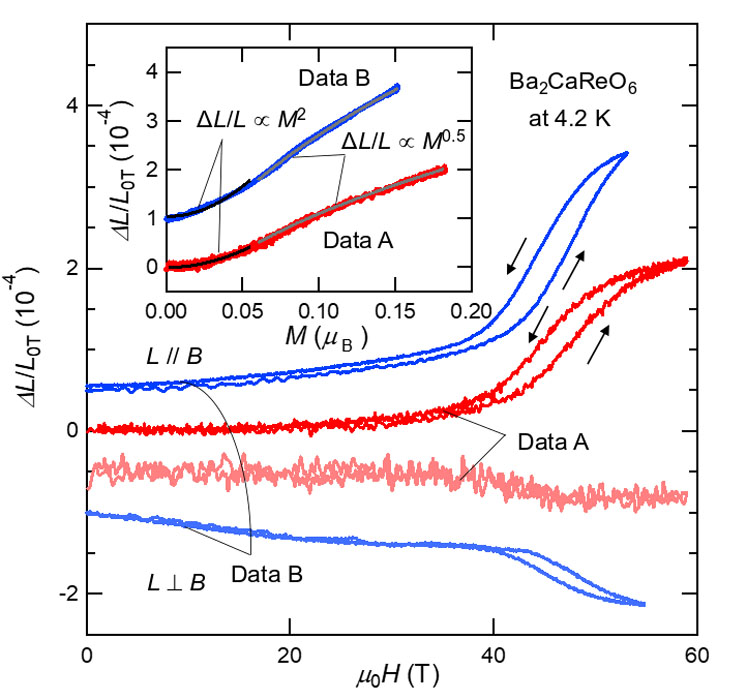Phase Transition in 5d1 Double Perovskite Ba2CaReO6 Induced by High Magnetic Field
Kindo, Y. Matsuda, and Hiroi Groups
Physical properties emerging from the combination effect of electron correlation and spin-orbit coupling have attracted considerable attention in the last decade. In 5d transition metal ions with partially filled t2g orbital, large spin-orbit coupling of 0.4 eV may entangle the effective orbital angular momentum and the spin angular momentum. The electronic state is described by the effective total angular momentum Jeff. For example, an unpaired electron in the d1 ion in the cubic octahedral crystal field occupies the Jeff = 3/2 quartet. In solids, interactions among spin-orbital entangled electrons may give rise to exotic ground states such as a spin liquid and multipolar orders. When the d1 ions with the Jeff = 3/2 state interact on the face-centered-cubic (FCC) lattice, unconventional ground states such as multipolar orders, spin-orbit dimer phase, and spin-orbital liquid may emerge. In the multipolar ordered states, magnetic dipolar, electric quadrupolar, and magnetic octupolar moments can be the order parameter. Magnetic properties of double perovskite-type oxides, chlorides, bromides, and lacunar spinel selenides have been investigated as Mott insulators with the Jeff = 3/2 state on the FCC lattice [1-4]. These examples demonstrate that various multipolar and dimer orders can be realized by applying a certain perturbation via non-magnetic cations and ligand anions.
Another way for exploring a novel electronic phase is applying strong magnetic field comparable to the magnitude of interactions among electrons. In the spin-1/2 Heisenberg model on the tetragonally distorted FCC lattice as seen in the rhenium double perovskite oxides at low-temperature, successive field induced magnetic phases including the 1/2-magnetization plateau may appear in the magnetization process. While the electric quadrupoles do not couple with magnetic field directly, a possibility of magnetic field induced quadrupolar transition has been discussed in CeB6, where the Ce atom with 4f1 electron configuration has Γ8 quartet ground state of which symmetry is identical to the Jeff = 3/2 quartet.
We focused on a rhenium double perovskite oxide Ba2CaReO6, which is a candidate of the Jeff = 3/2 Mott insulator with Re6+ (5d1) ions. The magnetization of Ba2CaReO6 was measured in the pulsed high magnetic field by changing the maximum magnetic field values up to 66 T as shown in Fig. 1 [5]. The magnetization curve at 4.2 K deviates from the linear behavior around 35 T and exhibits a steep increase at around 45 T, indicating the presence of a magnetic field induced phase transition. The full magnetic moment of Ba2CaReO6 estimated from the effective magnetic moment is 0.38 μB and thus the magnetization of 0.2 μB at the high field region is clearly smaller than the full moment. The magnetic field induced phase transition in Ba2CaReO6 was also clearly detected in the magnetostriction ΔL/L0T measured at 4.2 K as shown in Fig. 2. The longitudinal magnetostriction is positive and amounts to 2-3 ×10-4 at around 60 T, while the transverse magnetostriction is negative and amounts to ~1 ×10-4 at around 60 T. The longitudinal magnetostriction is plotted against magnetization in the inset of Figure 2. The magnetostriction changes quadratically to magnetization up to around 40 T. The deviation from the quadratic behavior is observed as increasing the field, suggesting a change in the way of spin-lattice coupling via orbital degrees of freedom. The magnetic field induced phase transition is attributed to the transition from the collinear to the canted antiferromagnetic orders with possible changes in the orbital states. Ba2CaReO6 would reside in the parameter regime close to the boundary between the two magnetic orders, representing a suitable material for investigating the interplay between the spin-orbital entangled electrons and magnetic field.
References
- [1] H. Ishikawa, T. Takayama, R. K. Kremer, J. Nuss, R. Dinnebier, K. Kitagawa, K. Ishii, and H. Takagi, Phys. Rev. B, 100, 045142 (2019).
- [2] H. Ishikawa, T. Yajima, A. Matsuo, Y. Ihara, and K. Kindo, Phys. Rev. Lett. 124, 227202 (2020).
- [3] H. Ishikawa, T. Yajima, A. Matsuo, and K. Kindo, J. Phys.: Condens. Matter 33, 125802 (2021).
- [4] D. Hirai, H. Sagayama, S. Gao, H. Ohsumi, G. Chen, T. Arima, and Z. Hiroi, Phys. Rev. Research 2, 022063 (2020).
- [5] H. Ishikawa, D. Hirai, A. Ikeda, M. Gen, T. Yajima, A. Matsuo, Y. H. Matsuda, Z. Hiroi, and K. Kindo Phys. Rev. B 104, 174422 (2021).


